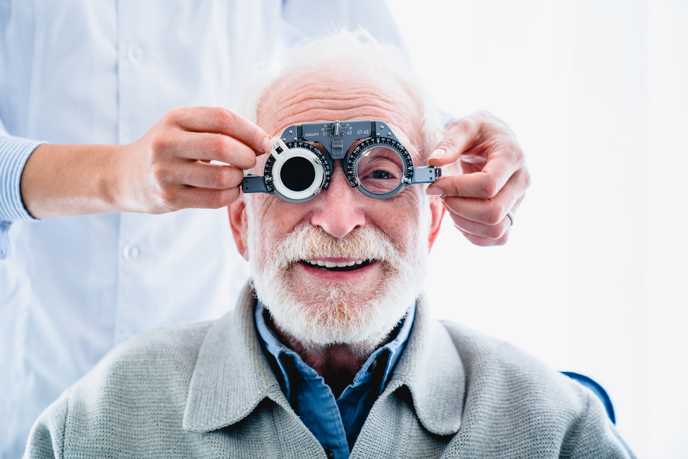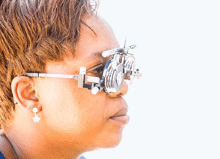What is Hyperopia?
Hyperopia, also known as farsightedness or long-sightedness, is a refractive error that makes it difficult to focus on objects nearby. In mild cases, people with hyperopia may still be able to see nearby objects clearly, especially when squinting. More severe cases may cause all near sight to be blurry.

There are millions of people with hyperopia all over the world and it is often left undiagnosed. Managing hyperopia can reduce your risk of developing other eye conditions, protect your eye health and improve your quality of life. Therefore, it is important to understand what causes hyperopia, how to identify it and the best ways to treat it.
Understanding the Symptoms of Hyperopia
The main symptoms of hyperopia are nearby objects appearing blurry or unfocussed, eye strain, squinting, headaches and fatigue. Many of these are exacerbated by doing close work; activities like reading, writing or working at a computer will be challenging for people with hyperopia and afterwards, they may experience eye strain, headaches and fatigue.
Hyperopia may initially have no noticeable symptoms but can still be spotted during an eye exam. Children with hyperopia may experience the symptoms above, but also rub their eyes or squint frequently and struggle with close work activities like reading or doing homework.

Most people are born with mild hyperopia and have it throughout their childhood but in most cases, their vision is corrected as their eyes develop. Childhood hyperopia usually does not cause blurry vision because children can compensate for the refractive error using the muscles around their eyes. If hyperopia persists or worsens as children get older, they may need treatment to avoid vision loss and other symptoms.
The vision loss caused by hyperopia means the eyes must work harder to focus on things nearby. This can lead to eye strain, headaches and difficulties in concentrating. For school-age children, dealing with undiagnosed hyperopia can be especially difficult. The condition also increases the risk of developing another eye condition like strabismus (eye misalignment) or amblyopia (lazy eye) (Kulp, 2014). Staying up-to-date with eye examinations and maintaining good eye health can help to minimise the risk of developing these conditions.
The Anatomy of the Eye and Hyperopia Causes
Hyperopia is a type of refractive error, which means it is caused by the way the eye focuses light. When light enters the eye, it has to pass through the cornea, a thin transparent layer on the front of your eye and the lens, which focuses light onto the retina. Hyperopia can occur when the eye is too short, which affects the way the lens focuses light on the retina, or when the cornea is too flat, which causes light to land behind the retina rather than on it. These kinds of refractive errors make it difficult to focus on objects close by, which causes the typical blurry vision people with hyperopia experience.
As with other refractive errors like myopia and astigmatism, hyperopia is attributed to various factors including genetics, health, and environment. While there is no direct cause that can be pinned down for hyperopia, a family history of the condition makes you more likely to have it, so people with hyperopic parents or close relatives are at greater risk.
Hyperopia Treatment: Your Options
Hyperopia can be effectively treated with prescription glasses, contact lenses and surgery. Most children are slightly hyperopic, and this usually does not require treatment. This is because their eyes are still flexible and can compensate to correct the refractive errors.
Correcting hyperopic vision with prescription glasses or contact lenses is a simple and affordable option. Both glasses and contact lenses work by correcting the refraction of light in the eye so it hits the retina; there are different types depending on your prescription and how well you can see at other distances. Glasses and contact lenses come in single-focal, bifocal, and multifocal options, so people with multiple vision problems can correct their eyesight for all distances.
Spherical contact lenses are usually used when hyperopia is the only issue. They have the same lens power throughout the surface of the lens, meaning they cannot treat astigmatism. For people with hyperopia and astigmatism, toric lenses may be a more appropriate option.
Several laser surgeries can be used to correct hyperopic vision, the most common of which is LASIK. This type of laser eye surgery works by creating a small flap on the surface of the cornea so it can be gently reshaped. This corrects the refractive error and allows the eye to process light correctly. LASIK is only possible with certain types of hyperopia, specifically when the issue is the shape of the cornea, and the cornea is thick enough to be reshaped. The procedure has a high success rate and serious complications like vision loss are extremely rare. Issues like dry eye, glare and minor vision problems are more common.

Other surgical options include PRK, which also involves using a laser to reshape the cornea. It differs from LASIK in that, rather than creating a flap in the cornea it removes a small amount of tissue. PRK has a longer recovery time but also has good results for vision and eye health.
Another option is IOLs; these are a type of artificial lens that are implanted within the eyes. They can correct the refractive error of hyperopia when the issue is the eye’s lens. IOLs may be available to those who cannot undergo laser surgery and tend to provide positive results. As with laser surgery, there are risks associated with IOLs, but serious complications are rare.
Your optometrist is best placed to recommend which way of correcting your vision is best for you — they will consider your routine, lifestyle, and eye health in helping you make a decision.







